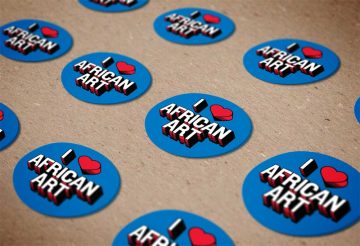Exhibition Examines Connections between African Art and Cultural Astronomy
“African Cosmos: Stellar Arts” will be on view at the Smithsonian’s National Museum of African Art from June 20 through Dec. 9. This is the first major exhibition exploring the historical legacy of African cultural astronomy and its intersection with traditional and contemporary African arts. The exhibition of some 100 objects considers how the sun, moon and stars and celestial phenomena such as lightning and rainbows serve as sources of inspiration in the creation of African arts from ancient times to the present. Far from abstract concepts, African notions of the universe are intensely personal and place human beings in relationships with earth and sky and with the sun, moon and stars.
“This exhibition, many years in the making, is part of the museum’s series focusing on Africa’s contributions to the history of knowledge—in this case, knowledge about the heavens and how this knowledge informs the creation of spectacular works of art,” said Christine Mullen Kreamer, deputy director and chief curator of the National Museum of African Art. “The project connects my lifelong fascination with sky-watching to the arts and cultures of Africa, which for decades have been my passion and the focus of my professional work.”
The exhibition features a selection of ancient Egyptian and Nubian artworks in wood, stone and papyrus, and 19th- and 20th-century masks, figures and ritual objects made by artists from regions south of the Sahara. The exhibition also includes works by internationally recognized contemporary artists who draw on the cosmos for inspiration, including El Anatsui, the late Alexander “Skunder” Boghossian, Willem Boshoff, Garth Erasmus, Romuald Hazoumè, Gavin Jantjes, William Kentridge, Julie Mehretu, Karel Nel, Marcus Neustetter and Berco Wilsenach.
Exhibition highlights include:
- An ancient Egyptian mummy board ornamented with a representation of Nut, the sky goddess
- Dogon (Mali) sculptures and masks that relate to origin myths connecting earth and sky
- Yoruba (Nigeria) sculptures honoring Shango, the thunder deity, and his wife, Oya, deity of the whirlwind
- Bamana (Mali) antelope crest pieces, whose open-work mane suggests the sun’s path through the sky each day
- Tabwa and Luba (Democratic Republic of the Congo) sculptures connected to ideas about the moon, enlightenment, and special insight
- A monumental sculpture “Rainbow Serpent” by Benin artist Hazoumè from repurposed plastic containers
- A meditative, interactive sculpture “Trembling Field” by South African artist Nel that explores the ephemeral qualities of light as it diminishes into the far reaches of space
About the Curator
Christine Mullen Kreamer is the deputy director and chief curator at the National Museum of African Art. Her exhibitions and publications explore art, ritual, gender, African systems of knowledge and museum practice. In addition to research in Togo, she has worked on museum training projects in Ghana and Vietnam. She has written articles, essays and books on traditional and contemporary African arts.
Catalog
A fully illustrated catalog accompanying the exhibition will be available mid-August in the museum store. Written by Kreamer, the volume also includes essays by noted scholars and artists.
Educational Programs
Interactive programs and events will accompany “African Cosmos: Stellar Arts,” designed to help visitors learn about African contributions to cultural astronomy and its connections to beliefs, values, and the arts. As part of its outreach activities, the museum has partnered to create cross-cultural, interdisciplinary educational programs with other Smithsonian museums, including: the Smithsonian Astrophysical Observatory, the National Air and Space Museum, the National Museum of the American Indian, the National Postal Museum and the Hirshhorn Museum and Sculpture Garden.
Artist Talk: Karel Nel
On June 21 from 6:00 to 7:30 p.m. in the National Museum of African Art’s Lecture Hall, Kreamer will converse with Nel, whose work explores a long-standing engagement with science, the history of art and the human journey. In 2004 Nel was invited to participate as an artist in residence in COSMOS, the Cosmic Evolution Survey. This ongoing project involving more than a hundred scientists around the world is charged with mapping a two-degree square area of the sky. Joining the conversation will be Nick Scoville, the Moseley Professor of Astronomy at the California Institute of Technology in Pasadena, who is the principal investigator of the Hubble Space Telescope imaging of COSMOS. The event, part of the museum’s “Artist Talk” series, is free and open to the public.
Support
Major sponsorship for “African Cosmos: Stellar Arts” is provided by the government of the Republic of South Africa and South Africa’s Department of Science and Technology. Additional support is from BET Networks, Stuart Bohart and family, Brand South Africa, Credit Suisse, South African Airways, South African Airways Cargo and the Embassy of South Africa in Washington, D.C.
About the National Museum of African Art<.h4>
The National Museum of African Art is the nation’s premiere museum dedicated exclusively to the collection, conservation, study, and exhibition of Africa’s traditional and contemporary arts. The museum is open daily from 10 a.m. to 5:30 p.m., except Dec. 25. Admission is free. The museum is located at 950 Independence Avenue S.W., near the Smithsonian Metrorail station on the Blue and Orange lines. For more information, call (202) 633-4600 or visit the National Museum of African Art’s website. For general Smithsonian information, call (202) 633-1000.
